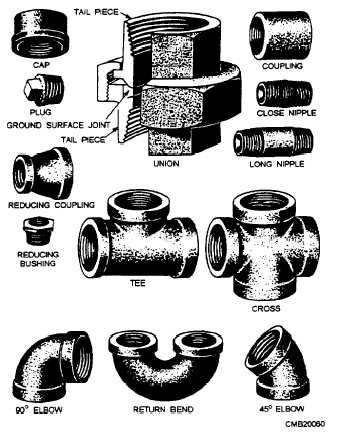Outer Cover. - The outer cover protects the reinforcement layers. A special rubber is most commonly used for the outer layer because it resists abrasion and exposure to weather, oil, and dirt.
Flexible hose is provided in four-pressure ranges. Low pressure is used in a low-pressure system and for the exhaust lines of high-pressure systems. Medium- pressure hose is used in systems with pressures up to 1,200 psi; high-pressure hose is used with pressures up to 3,000 psi; and extra-high-pressure hose is used in systems with pressures up to 5,000 psi. High- and extra- high-pressure hoses normally come as complete assemblies with factory installed end fittings. Medium- and low-pressure hose are available in bulk and are usually fabricated locally.
Flexible hose must NOT be twisted on installation, since this reduces the life of the hose considerably and may cause fittings to loosen as well. You can determine whether or not a hose is twisted by looking at the lay line that runs along the length of the hose. This lay line should not tend to spiral around the hose (fig. 3-37).
Hose should be installed so that it will be subjected to a minimum of flexing during operation. Support clamps are not necessary with short installations, but with hoses of considerable length (48 inches for example), clamps should be placed not more than 24 inches apart. Closer supports are desirable and, in some cases, needed. Hose must
NEVER be stretched tight between two fittings. About 5 to 8 percent of the total length must be allowed as slack to provide freedom of movement under pressure. When flexible hose is under pressure, it contracts in length and expands in diameter. Examples of correct and incorrect installations of flexible hose are shown in figure 3-37.
Connectors and Fittings There are many types of connectors and fittings required for a fluid power system. The type of connector or fitting depends upon the type of circulatory system (pipe, tubing, or flexible hose), the fluid medium, and the maximum operating pressure of the system. Some of the most common connectors and fittings are described in the following paragraphs.
THREADED CONNECTORS. - Threaded connectors (fig. 3-38) are used in low-pressure pipe systems. The connectors are made with standard pipe threads cut on the inside surface of the connector. The end of the pipe is threaded on the outside for connecting with the connector. Standard pipe threads are tapered slightly to ensure a tight connection.

Figure 3-37. - Correct and incorrect installation of flexible hose.

Figure 3-38. - Threaded pipe connectors.
Continue Reading